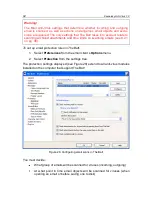
CHAPTER 9.
WEB ANTI-VIRUS
Whenever you use the Internet, information stored on your computer is open to
the risk of infection by dangerous programs, which can penetrate your computer
when you read an article on the Internet.
Web Anti-Virus
is Kaspersky Anti-
Virus‟s component for guarding your computer
during Internet use. It protects information that enters your computer via the
HTTP protocol, and also prevents dangerous scripts from being loaded on your
computer.
Warning!
Web Anti-Virus only monitors HTTP traffic that passes through the ports listed on
the
monitored port
list (see 15.4 on pg. 171). The ports most commonly used for
transmitting email and HTTP traffic are listed in the program package. If you use
ports that are not on this list, add them to it to protect traffic passing through
them.
If you are working on an unprotected network, you are advised to use Web Anti-
Virus to protect yourself while using the Internet. Even if your computer is run-
ning on a network protected by a firewall or HTTP traffic filters, Web Anti-Virus
provides additional protection while you browse the Web.
The component‟s activity is indicated by the Kaspersky Anti-Virus icon in the
taskbar notification area, which looks like this
whenever scripts are being
scanned.
Let‟s look at the component‟s operation in more detail.
Web Anti-Virus consists of two modules, that handle:
Traffic scan
– scans objects that enter the user‟s computer via HTTP.
Script scan
– scans all scripts processed in Microsoft Internet Explorer,
as well as any WSH scripts (JavaScript, Visual Basic Script, etc.) that
are loaded while the user is on the computer.
A special plug-in for Microsoft Internet Explorer is installed as part of
Kaspersky Anti-Virus installation. The
button in the brows
er‟s Stan-
dard Buttons toolbar indicates that it is installed. Clicking on the icon
opens an information panel with Web Anti-Virus statistics on the number
of scripts scanned and blocked.
















































